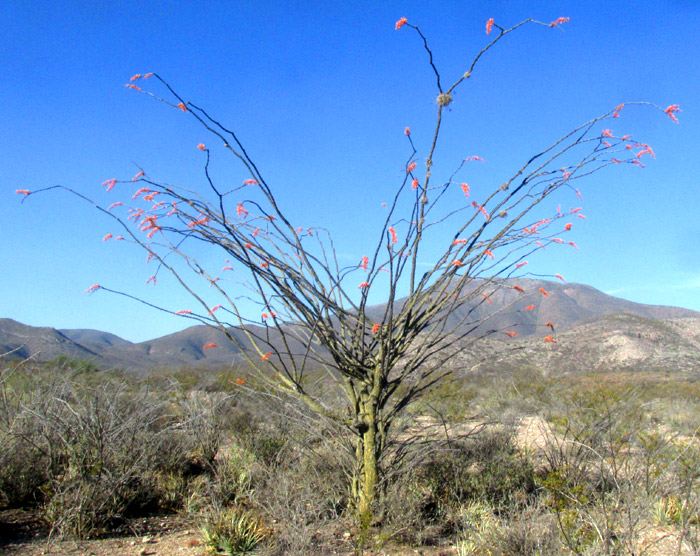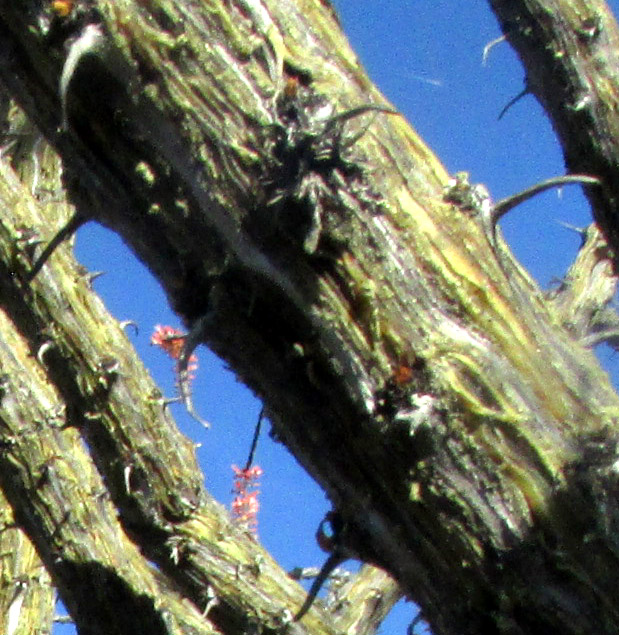Excerpts from Jim Conrad's
Naturalist Newsletter
from the February 23, 2007 Newsletter issued from Sierra Gorda Biosphere Reserve; about 2kms south of Camargo, Querétaro, ~N21.09°, ~W99.73°, elevation about 1700m, 5500ft; central QUERÉTARO state, MÉXICO
OCOTILLO

Above, a leafless Ocotillo is flowering. The English name Ocotilla is taken directly from Spanish into English. It's such an unusual plant that it has its own family, the Ocotillo Family, the Fouquieriaceae, which contains only the genus Fouquieria.
I'm not sure which Fouquieria we have in this area.* The one in the US Southwest is F. splendens. The species name splendens hints at why ocotillos are so popular among nature folks.
The above picture suggests Ocotillo's singular strangeness -- its long, slender, spiny, arching stems tipped with flowers is unlike anything else -- but there's little splendiferousness to see. Ocotillos are splendid mainly after heavy rains. Most of the year they consist of the leafless, spiny branches shown in the picture, but about three days after a soaking rain they adorn themselves with small, emerald-green leaves. Below you can see a raceme-type flowering head, which also is splendid to behold:

An Ocotillo's first leaves possess pronounced petioles, or stems, and midribs. When these leaves die, their petioles and part of their midribs remain on the stem and harden into the slender, curved spines you see in the above image. At spine bases arise tiny, hardly visible "short-shoots" (as opposed to the spiny "long-shoots" in the picture), from which new leaves arise each time there's a good rain. This short-shoot/long-shoot business is unusual in the plant world and supports the conclusions of recent gene analysis that Ocotillos aren't closely related to any other kind of plant.
You can guess from the flowers' shape and red color that they're very attractive to hummingbirds. Ants and ground squirrels eat the flowers.
Entry dated March 7, 2024, from notes taken about 2kms south of Higuerillas, Municipality of Cadereyta de Montes; N20.8884°, W99.7691°, elevation ~1660 meters (~5450 feet); soil derived from unconsolidated mixed-size particles and sand deposited during the late Pliocene and early Pleistocene epochs; local narrow belt of vegetation constituting an extreme southern extension of the Chihuahuan Desert, Meridional Subregion; central Querétaro state, MÉXICO
MORE PICTURES
 Years later I have a camera capable of taking pictures closer up, so at the right you can get an idea of what the above discussion of long and short shoots refers to. Below, a dissected flower displays a style divided into three branches surrounded by ten stamens of which five are shorter than the others:
Years later I have a camera capable of taking pictures closer up, so at the right you can get an idea of what the above discussion of long and short shoots refers to. Below, a dissected flower displays a style divided into three branches surrounded by ten stamens of which five are shorter than the others:

Below you see the semi-succulent trunk with its many spiny branches.

At the trunk's base, notice the two small, fingerlike Garambullo cactus seedlings taking advantage of the Ocotillo's more potent spiny defenses.
Since the above 2007 entry was made, genetic analysis has developed interesting insights about the ocotillo species. For example, in the 2018 study by José Arturo de Nova Vázquez and others entitled "Recent radiation and dispersal of an ancient lineage: The case of Fouquieria (Fouquiericeae, Ericales) in North American deserts," it's stated that the ocotillo genus Fouquieria is an ancient lineage that diverged from the Phlox Family, the Polemoniaceae. The splitting off from the Phlox Family occurred about 75.5 million years ago, then about 12.7 million years ago ancestral Fouquieria forms underwent a high speciation rate, accompanied by a negligible extinction rate. Today about eleven ocotillo species are recognized, all endemic just to southern California and southwestern Texas, south throughout the dry parts of Mexico.
The ocotillo genus Fouquieria was introduced to science by collections made in our area by Humboldt and Bonpland, and published in 1823 by the German botanist Kunth.